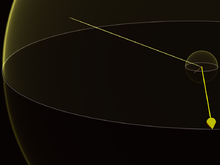ਪ੍ਰਕਾਸ਼-ਸਾਲ
ਦਿੱਖ

ਇੱਕ ਪ੍ਰਕਾਸ਼ ਸਾਲ (ਚਿੰਨ੍ਹ: ly) ਲੰਬਾਈ ਮਿਣਨ ਦਾ ਇੱਕ ਸਾਧਨ ਹੈ। ਇੱਕ ਪ੍ਰਕਾਸ਼-ਸਾਲ ਲੱਗ-ਭੱਗ 10 ਅਰਬ ਕਿਲੋਮੀਟਰ ਦੇ ਬਰਾਬਰ ਹੂੰਦਾ ਹੈ। ਇੰਟਰਨੈਸ਼ਨਲ ਐਸਟਰੋਨੋਮੀਕਲ ਯੂਨੀਅਨ ਦੇ ਮੁਤਾਬਕ ਰੋਸ਼ਨੀ ਇੱਕ ਸਾਲ ਵਿੱਚ ਜਿੰਨਾ ਸਫਰ ਤਹਿ ਕਰਦੀ ਹੈ, ਉਸ ਲੰਬਾਈ ਨੂੰ ਇੱਕ ਪ੍ਰਕਾਸ਼-ਸਾਲ ਕਹਿੰਦੇ ਹਨ।[1] ਪ੍ਰਕਾਸ਼-ਸਾਲ ਨੂੰ ਤਾਰਿਆਂ ਦੀ ਦੂਰੀ ਦਾ ਪਤਾ ਕਰਨ ਲਈ ਵਰਤਿਆ ਜਾਂਦਾ ਹੈ।
Numerical value
[ਸੋਧੋ]ਇੱਕ ਪ੍ਰਕਾਸ਼-ਸਾਲ:
- 9,460,730,472,580.8 ਕਿਲੋਮੀਟਰ ਹੁੰਦਾ ਹੈ
- ਲੱਗ-ਭੱਗ 5,878,630,000,000 ਮੀਲ ਹੁੰਦਾ ਹੈ
ਉੱਪਰ ਲਿਖੇ ਅੰਕੜੇ ਜੂਲੀਅਨ ਸਾਲ ਦੇ ਹਿਸਾਬ ਨਾਲ ਹਨ, ਜਿਸ ਵਿੱਚ 365.25 ਦਿਨ ਹੁੰਦੇ ਹਨ।[2] ਅਤੇ ਪਹਿਲਾਂ ਹੀ ਤਹਿ ਕੀਤੀ ਰੋਸ਼ਨੀ ਦੀ ਗਤੀ, ਜੋ 299,792,458 ਮੀਲ ਇੱਕ ਸੇਕੰਡ ਵਿੱਚ ਹੈ, ਇਨ੍ਹਾਂ ਦੀ ਵਰਤੋਂ 1984 ਤੋਂ ਹੋ ਰਹੀ ਹੈ।[3]
| Factor (ly) | Value | Item |
|---|---|---|
| 10−9 | 40.4×10-9 ly | Reflected sunlight from the Moon's surface takes 1.2-1.3 seconds to travel the distance to the Earth's surface. (The surface of the moon is roughly 376300 kilometers from the surface of the Earth, on average. 376300 km ÷ 300000 km/s (roughly the speed of light) ≈ 1.25 seconds) |
| 10−6 | 15.8×10-6 ly | One astronomical unit (the distance from the Sun to the Earth). It takes approximately 499 seconds (8.32 minutes) for light to travel this distance.[4] |
| 10−3 | 3.2×10-3 ly | The most distant space probe, Voyager 1, was about 14 light-hours away from Earth 9 ਮਾਰਚ 2007 ਤੱਕ [update]. It took that space probe 30 years to cover that distance.[5] |
| 100 | 1.6×100 ly | The Oort cloud is approximately two light-years in diameter. Its inner boundary is speculated to be at 50,000 AU, with its outer edge at 100,000 AU |
| 2.0×100 ly | Maximum extent of the Sun's gravitational pull (hill sphere/roche sphere, 125,000 AU). Beyond this is true interstellar space | |
| 4.22×100 ly | The nearest known star (other than the Sun), Proxima Centauri, is about 4.22 light-years away.[6][7] | |
| 103 | 26×103 ly | The center of our galaxy, the Milky Way, is about 8 kiloparsecs away.[8][9] |
| 100×103 ly | The Milky Way is about 100,000 light-years across. | |
| 106 | 2.5×106 ly | The Andromeda Galaxy is approximately 2.5 megalight-years away. |
| 3.14×106 ly | The Triangulum Galaxy (M33), at 3.14 megalight-years away, is the most distant object visible to the naked eye. | |
| 59×106 ly | The nearest large galaxy cluster, the Virgo Cluster, is about 59 megalight-years away. | |
| 150×106 - 250×106 ly | The Great Attractor lies at a distance of somewhere between 150 and 250 megalight-years (the latter being the most recent estimate). | |
| 109 | 1.2×109 ly | The Sloan Great Wall (not to be confused with the Great Wall) has been measured to be approximately one gigalight-year distant. |
| 46.5×109 ly | The comoving distance from the Earth to the edge of the visible universe is about 46.5 gigalight-years in any direction; this is the comoving radius of the observable universe. This is larger than the age of the universe dictated by the cosmic background radiation; see size of the universe: misconceptions for why this is possible. |
ਹਵਾਲੇ
[ਸੋਧੋ]- ↑ "The IAU and astronomical units". International Astronomical Union. Retrieved 2008-07-05.
- ↑ "IAU Recommendations concerning Units". Archived from the original on 2007-02-16. Retrieved 2009-02-23.
{{cite web}}: Unknown parameter|dead-url=ignored (|url-status=suggested) (help) - ↑ Astronomical Constants Archived 2009-03-27 at the Wayback Machine. page K6 of the Astronomical Almanac.
- ↑ IERS Conventions (2003) Archived 2014-04-19 at the Wayback Machine., Chapter 1, Table 1-1.
- ↑ NASA pressrelease (05-131) 2005-05-24: Voyager Mission Operations Status Report Week Ending March 9, 2007
- ↑ NASA: Cosmic Distance Scales - The Nearest Star
- ↑ Proxima Centauri (Gliese 551), Encyclopedia of Astrobiology, Astronomy, and Spaceflight
- ↑ F. Eisenhauer, et al., "A Geometric Determination of the Distance to the Galactic Center[permanent dead link]" (pdf, 93KB), Astrophysical Journal 597 (2003) L121-L124
- ↑ McNamara, D. H., et al., "The Distance to the Galactic Center" (pdf, 298KB), The Publications of the Astronomical Society of the Pacific, 112 (2000), pp. 202–216.
